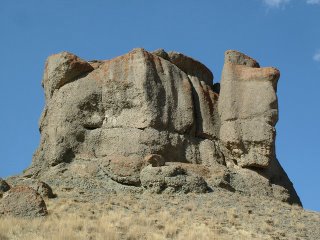
"Gorkhu Dada" is a stone monument in a valley called Tangry Dada near Anbaran, a pleasant city with a mild climate, located 40 km from Ardebil, Iran.

Located over a 100m high hill, this monument with a height of 30m and a width of 6m has a human face characteristic including eyes, nose, mouth and chin. It was discovered by an Ardabili Mountaineer, Mr. Sageb Hamidi, in 1998. However, it has not got enough attention from the Cultural Heritage Organization of Iran so far. Without any scientific reason, they argue that there has not been any human interference in its building process and consider it all made by nature.
According to parts A and B of 3rd article of International Council on Monuments and Sites (ICOMOS) constitution adopted in 22 June 1965 in Warsaw and modified in its 4th General Assembly in Rothenberg on 26th May 1975, any set of human-made objects, human modification of natural environment or just strictures uniquely made by nature should be preserved and protected as human heritage and carries a public importance.
Due to archeological and historical importance of this structure, study and research of the monument can assist in discovering and knowing of unknown civilizations of Azerbaijan. Due to huge deprivation of Ardabil Province and specially Namin district, giving special attention to this monument, registering and introducing it can bring cultural tourism to the area.
Tourism industry is the third most important sector in the economy after oil and car industries. Investing in this industry in Azerbaijan region of Iran specially Ardebil province which enjoys a rich history and natural resources as Savalan mountain, extraordinary warm mineral springs of Sarein, and many tourism attractions of Germi, Parsa-abad, Khalkhal, Namin, Bilesovar, Beautiful Heyran Ghat, Fandoglu Jungles, and so on can help this province to get rid of deprivation.
It should be noted that, the official centralism policy in the region has resulted in draining both brain and wealth to the capital of Iran, Tehran and outside the country and many efforts have been put to assimilate Azerbaijani people of the region by mass media and broadcasting organizations. Refusing to register this monument as part of cultural heritage is also done in this direction. Due to gradual disintegration and natural erosion of this monument, we ask prompt attention and special consideration of officials of Iran’s Cultural Heritage and International Council on Monuments and Sites (ICOMOS) to research and study of this monument and its possible registration as a human heritage.

- To conscientious Soles
- New Address
- The revolation court of Khoy imprisoned an Azerbai...
- About the foundation of the Azerbaijan Democrat Pa...
- Pictures of Satarkhan Ceremony
- Safar khan Qahramanian
- The conference of AEI
- The Unknown Iran, Another Case for Federalism?
- Iran: Fear for safety/fear of torture or ill-treat...
- A Little Fighter Against Organized Persian Chauvin...